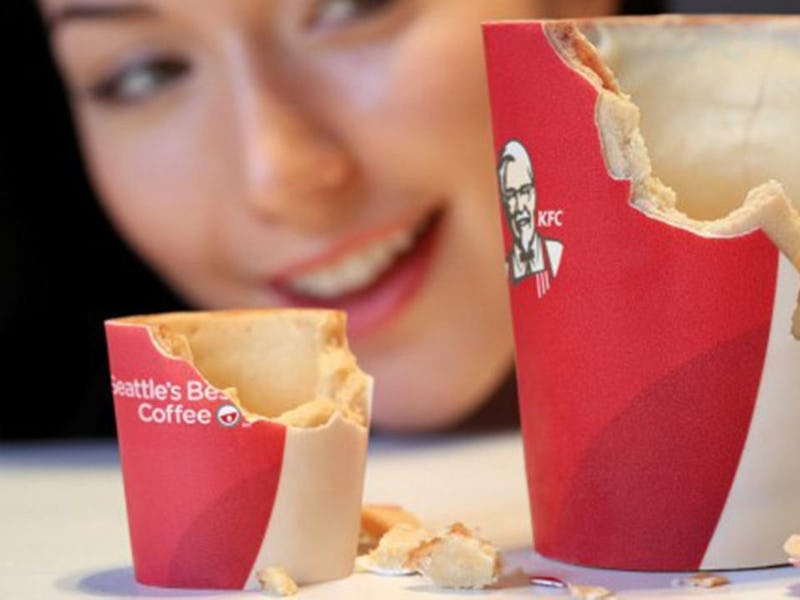KFC's Edible Bowl Will Lead a Populist, Sustainable Table Manners Revolution
The soul of good manners is prioritizing the greater good. Munch away.

Edible packaging is inevitable. Look at KFC India: Starting in April it became the first part of the Yum! Brands empire to swap out plastic bowls in favor of edible ones. The vessels in question? “Rice Bowlz,” which are basically just the sort of tortilla bowls; you might find on a counter at Baja Fresh or Donald Trump’s Instagram. The Bangalore trial is just that, a trial, but the adoption of edible bowls, caps, plates, and utensils already feels invariable. High-density cities have a trash problem that they can’t currently compost their way out of. The human digestive system may be a viable short-term solution as large-scale, sustainable waste-disposal systems come online — if we get comfortable eating this stuff.
Researchers, like Saef Ahmand of the University of Texas, see edible containers as the practical, predictable backlash to single-use plastics — the worst offenders against the marine environment. As more local and federal governments ban plastic, we’ll likely see an uptick in edible packaging.
This is the second go at offering edible tableware for KFC, which last year served up an edible-wafer cup with its coffee. These cups doubled-up on the psychological factor of the eating process: They were manufactured to smell like “coconut sun cream” and “wild flowers” — the hope being, that these scents, which really seem more like body-sprays, would “make everyone smile.” But, while KFC remains the most well-known brand in the edible-container game, it’s not alone. Stonyfield Farm, Inc. sells yogurt in edible packaging, called WikiPearls and Loliware is a company solely focused on creating single-use cups made from seaweed and organic sweeteners. Harvard scientist David Edwards has developed an edible peel made from algae and other natural materials which can hold anything from cold soup to a cocktail.
A KFC edible bowl for the "Rice Bowlz."
Humans are, focus groups suggest, always down to snack. But the fascinating thing about consuming flatware and cups is that we don’t know how to do it properly. Our parents never taught us, and their parents never taught them. We need edible bowls, sure, but also a new set of social norms to go with them. And we probably shouldn’t look to KFC for leadership on that front.
Here are the five rules we suggest consumers observe until society has its ultimate say:
Wash Your Edible Polymer
This is only for manufactured edible wrappers like Edward’s cocktail balls, not for edible containers that are made of actual foods — like Tomorrow Machine’s packages made from caramelized sugars and beeswax rice packages. And there’s a specific reason. Edwards told PBS to basically think of his packaging as an apple peal.
“I get home, and I hand [the food] to my son, and he hands it to his friend,” Edwards said. “And then the friend says, ‘But did you wash your hands?’ At that point, I clean it as I do fruit and vegetables today. I can run water over it, and it doesn’t dissolve, actually. And it can be cleaned, and then I can eat it.”
Eat Buffet Style
If you are eating food wrapped in other food, you shouldn’t be passing out bowls. The approach should be to seek as little contact with other peoples’ meals as is physically possible. This will no doubt lead to some standoffishness at first, but we’ll all get over it.
Packaging and Utensils Are the Same Thing
In the 1876 version of Mrs. Beeton’s *Complete Etiquette for Ladies, the Victorian arbiter of manners recommended that people use a piece of bread in their left hands to delicately push food onto right-handed forks. Edible packaging is easily adapted to this sort of decorum.
Slurp
It’s also worth bearing in mind that before the advent of etiquette manuals, most people skipped spoons and drank soup straight from bowls. There is a precedent for most types of efficient behavior.
A classic edible-bowl favorite: The bread bowl.
Don’t Judge People For Using Edible Containers
From the late 19th century to today, dinner parties have been used as an assertion of class. As such, families have invested in a lot of stemware and crystal. There’s nothing wrong with that; many vessels are quite beautiful. That said, it’s hard to move forward if progress is considered low rent. Though crystal doesn’t represent a trash problem — unless one attends solely Gatsby-esque soirées — the water used by dishwashers absolutely does. So using edible containers at a private function makes total sense as an environmentally conscious decision. If the soul of good manners is for the common good, it makes little sense to scorn people for shrinking their environmental footprint.
When it comes time to serve a meal, remember that tasty is the new beautiful.